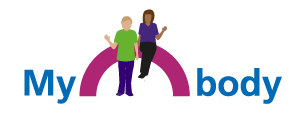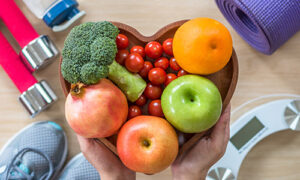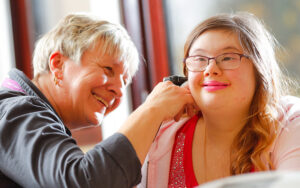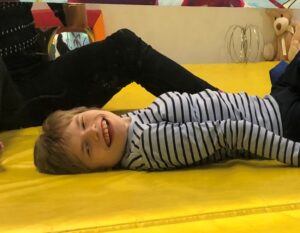
Staying healthy
Healthy living is something that is spoken about a lot. It means eating healthy food and keep active through the choices that we make. It can improve our health, reduce the risk getting ill or dying early.
 It is something that we should be doing every day or supporting other people to do.
It is something that we should be doing every day or supporting other people to do.
- If you eat too much you might get overweight and this can make you ill.
- If you don’t eat enough you may become tired and ill.
You can check if you are a healthy weight by putting your weight and height into this BMI calculator.
Balanced diet
Eating a healthy, balanced diet is an important part of having good health and can help you feel your best.
 People who are overweight have an increased chance of stroke, heart attack, cancer, high cholesterol, gallstones, osteoarthritis and diabetes. People who are underweight are at an increased risk of malnutrition, osteoporosis, decreased immune function and growth and development issues.
People who are overweight have an increased chance of stroke, heart attack, cancer, high cholesterol, gallstones, osteoarthritis and diabetes. People who are underweight are at an increased risk of malnutrition, osteoporosis, decreased immune function and growth and development issues.
There are lots of tips here (food smart films) to help you to eat a healthy diet and stay well
To have a healthy, balanced diet, you should try to:
- eat at least five portions of a variety of fruit and vegetables every day (see 5 A Day)
- base meals on higher fibre starchy foods like potatoes, bread, rice or pasta
- have some dairy or dairy alternatives (such as soya drinks)
- eat some beans, pulses, fish, eggs, meat and other protein
- choose unsaturated oils and spreads, and eat them in small amounts
- eat the right foods in the right amount
- drink plenty of fluids (at least six to eight glasses a day).
Using the toilet
You should check the colour of your wee. If it’s too dark it may mean you are not drinking enough water. Some food and medication can change the colour of your wee.
 We can’t survive without water. It is essential for your body to function properly. Water has a wide range of benefits for your body. It removes waste products in your wee, regulates your body temperature, prevents infections and keeps your body working properly.
We can’t survive without water. It is essential for your body to function properly. Water has a wide range of benefits for your body. It removes waste products in your wee, regulates your body temperature, prevents infections and keeps your body working properly.
If someone has not drunk enough, it can cause headaches, confusion, tiredness, vomiting, and there is a risk of infection, such as urinary tract infections, seizures and needing emergency care. It can also contribute to constipation.
Find out more:
You should be able to have a poo easily with no effort or pain. If you find that having a poo is painful, you notice blood in your poo, you have belly aches or you have runny poo (diarrhoea) for longer than two weeks, ask your GP for help.
If you find it difficult to poo (have constipation) there is some useful information here to help you - Constipation (from NHS.uk).
Eating and drinking
 There are lots of things you can do to help make eating and drinking safer and more pleasurable. Here are some guidelines.
There are lots of things you can do to help make eating and drinking safer and more pleasurable. Here are some guidelines.
However, if you are worried; or if the person you care for has had a choking incident or chest infections; or if you feel their swallowing has changed and it is more difficult, please seek advice from your speech and language therapist or your GP. In an emergency, please contact
Eyes and ears
Eyes
You might have problems with your eyes if:
- You see a change in appearance, for example, bloodshot, milky or cloudy
- you need to hold objects close to your face to see them
- you walk into things or use your hands to feel walls around you.
Ears
 You might have problems with your hearing if:
You might have problems with your hearing if:
- You turn the TV or radio up loud
- you find it hard to work out where sounds are coming from
- you raise your voice.
Speak to your doctor or the Learning Disability Team if this applies to you.
Getting ready for a hearing test
If you think you have any problems with your hearing, you should tell your GP. They will get you help if needed and may ask you to have hearing test.
How to have a good hearing test
Before you go:
Try practising at home. Play a game where every time you hear a sound coming from a speaker, you see how quickly you can respond. You might like to give a thumbs up, clap your hands, shout out a word or throw a beanbag or ball – whatever you feel like doing.
When your appointment letter arrives:
Make sure they know that you have a learning disability. This means they can make reasonable adjustments for you.
At your appointment:
- Ask your specialist to explain anything you don’t understand
- say if you need a break
- ask for a written report afterwards
- if you get hearing aids, you may have a choice of colour. Ask!
Getting ready for an eye test
Before booking your eye test
Fill out SeeAbility’s ‘Telling the optometrist about me’ form, available from their Eye care fact sheets page on their website.
Try practising at home. Things you can try include:
- Practise having a soft light (for example, pen light / not a mobile phone light!) shone at your eyes for a few seconds.
- Practise allowing someone to look at your eyes closely.
- Practise recognising pictures from across the room – simple line drawings are best, but any simple image (e.g. house) will do.
- Practise with the Peek Acuity Pro app if you have a phone or tablet.
- Practise looking up, down, left and right.
When booking your eye test:
Let the optician know that you have a learning disability. This means they are then able to make reasonable adjustments for you.
Ask them if you can send them your completed ‘Telling the optometrist about me’ form ahead of your appointment. This helps them to get to know you better before you arrive.
You may not need to pay for your eye check. Check to see if you can get a free eye check.
Reasonable adjustments
Here are some examples that could help someone with a learning disability to have an eye check:
- Having it early in the day to avoid waiting
- having extra time
- using pictures instead of letters
- using a matching sheet if you are unable to say or sign what you can see
- Using a preferential looking test for example, Cardiff acuity test if find it hard to communicate what you can see.
Self-management
Ear wax
Ear wax is natural and helps protect the ear. Sometimes it can build up and block your ear.
Signs your ears may be blocked with wax:
- Earache
- itchiness
- dizziness
- ear infection
- sounds inside the ear (known as tinnitus).
You can’t prevent earwax - it’s there to protect your ears from dirt and germs. But you can keep using oil drops to soften recurring wax build up.
Don’t put cotton buds, Q tips or ear candles in your ear. You can damage your ear or increase the risk of infection.
Don’t use drops if you have a perforated eardrum. If you’re not sure, ask your GP.
How to treat ear wax yourself:
Lay on your side if you can. Gently pull your ear back and upwards to open.
Put a few drops of olive or almond oil in your ear. Do this twice a day for a few days.
Gently massage your ear to help the oil work its way down. Stay lying down for five to 10 minutes if you can.
Ask a pharmacist for advice and treatments. They may recommend special chemical eardrops to dissolve your earwax.
See your GP if:
- Your ear hasn’t cleared at all after a week of regular use of oil drops
- your ear is badly blocked and you can’t hear anything.
Blepharitis
Signs you may have blepharitis:
- Sore eyelids
- itchy eyes
- flakes/dry build up around the eyelashes
- red eyes and eyelids
- eyelids sticking together when you wake up.
Clean your eyelids at least once a day and continue to clean your eyelids even after symptoms have gone.
Don’t wear contact lenses or use make up – especially eyeliner – while your eyes are sore.
How to clean your eyes:
- Soak a flannel in warm water and place on your eyes for 10 minutes
- close your eyes and gently massage your eyelids for 30 seconds
- clean your eyelids using a make up wipe or a cotton bud. Be careful – if you are cleaning someone else’s eyelids use a flat finger with a wipe or flannel
- gently wipe along the edge of the eyelid, removing any scaly build up on the eyelash roots and eyelids.
When to see your GP
If your eyes are still sore after two weeks.
Physical activity and movement
Physical activity means sport, fitness exercises and body movements.
This can be walking, getting up and down stairs, running, swimming or having someone help you to move your arms and legs.
Sport and dance are also physical activities. This includes things like cycling or playing football with a team or joining games of badminton, bowling or Zumba.
Why is being active important?
 Physical activity and sport is good for your health and fitness.
Physical activity and sport is good for your health and fitness.
- Being active can help you to maintain a healthy body weight and shape
- It lowers the chance of you getting health problems like diabetes and heart disease and can help you to live longer
- You can improve your confidence, learn new skills and make friends
- Physical movement can reduce pain and joint stiffness and help your balance
- It can help you improve your sleep and memory and make you feel good
- Playing sport does not mean you have to take part in competitions you can play in a team for fun at your local sports club or leisure centre
Using equipment to help you move
Sometimes people need to use equipment to help them be mobile and active. This might be a walking stick or frame or could be a wheelchair or a mobility scooter.
People who find it difficult to stand up might also use equipment like grab rails or riser armchairs or may use a standing or lifting hoist to help them to move. If you are helping someone to use equipment to stand or to transfer make sure you have advice from a physiotherapist or occupational therapist and some training in safe moving and handling.
Video to show how to help someone to move their arms and legs.
 Helping someone to move their body and their arms and legs is very helpful for mobility and comfort for their joints, muscles and ligaments.
Helping someone to move their body and their arms and legs is very helpful for mobility and comfort for their joints, muscles and ligaments.
- It can help to keep soft tissues stretched and prevent joints becoming tight
- Regular movement maintains blood circulation which reduces the risk of pressure ulcers or blood clots
- Assisted exercise programmes help the person to carry out active movements to participate in activities and functional skills.
Breathing well
 Keeping a clear chest and lungs can help to reduce chest infections or hospital visits and will make you feel well and healthy.
Keeping a clear chest and lungs can help to reduce chest infections or hospital visits and will make you feel well and healthy.
- Keep active and move about regularly – exercise which makes you breathe more deeply for a short while is helpful
- Think about your posture – sit in a relaxed and upright position particularly when you are eating and drinking
- Practice huffing or blowing to help clear your chest – blowing out candles, laughing or blowing bubbles can help
- If you need to cough try to take a few deeper breaths beforehand. One or two stronger coughs are more effective than lots of little coughs
- Put your hands on your lowest ribs and see if you can make them swell outwards as you breathe in for a few breaths – this is called diaphragmatic breathing and is very good for singing!
Helping someone to clear their chest if they have a weak cough
This video demonstrates how to use a “cupping” action to shake secretions free from the lung walls and make it easier to cough them out. Please look at the person’s physiotherapy programme or care plan before starting.
- Cupping can be helpful for someone who is sounding wet or rattly when they breathe or who is finding it difficult to cough effectively. Remember to have tissues close at hand.
- Make sure you have clearly explained what you are going to be doing so that you can both agree to the activity. Always wait at least 30/40 minutes after eating or drinking.
- Cupping can be done in a sitting position particularly over the front of the chest but is most effective with someone lying on their side in bed (one side and then the other).
- Make sure you are both comfortable and the person has their head and limbs supported by pillows and that you can reach both the front and back of their chest without stooping. A thin hand towel over the chest will also make the cupping more comfortable.
- Identify the area of the lungs – this is under the rib cage (do not go down the bottom two ribs and avoid the person’s spine). Stand close to the person with the bed at a comfortable height.
- Hold your hands in a cupped shape and cover the chest wall with steady “cups” using either one or two hands. The person should breathe in a relaxed manner throughout – Continue for between 5 and 10 minutes on each side – keep checking with the person that they are happy to continue and finish the session if they ask or indicate that they would like to stop.
Equipment to help people breathe deeply and cough effectively
You may also be using equipment to help you breathe more easily or to help with coughing. This might be a shaker or bubble device to practice huffing outwards or a vibrating cushion to put against your chest to shake secretions.
You may have more specialist equipment – a nebuliser, a CPAP machine to help you breathe, oxygen cylinders, an oral suction machine or tracheostomy tubing for lung access and care. If you would like any further help with equipment that you currently have or that might have been recommended please talk to your GP. They may also refer you for respiratory or physiotherapy advice.